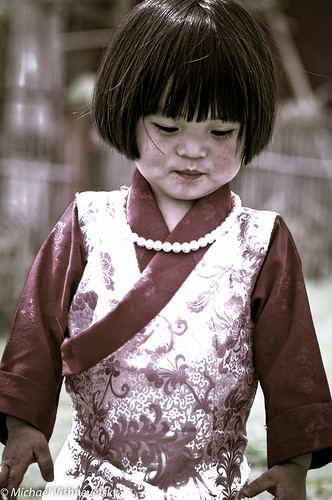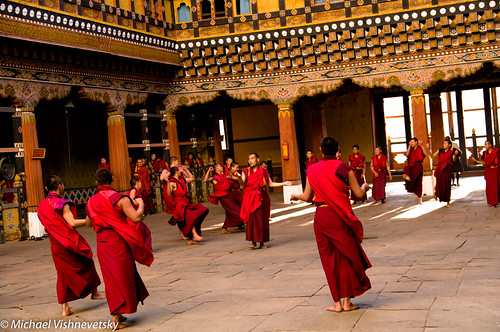Last night, we were all excited to see the showers outside, because it could have allowed us a later wake-up. Today, we begrudgingly woke up at 5:30am in order to make it in time for the Climbathon at Mount Santubong/Damai Resort. This event was organized by DBKU, which is the Commission of The City of Kuching North, and was intended for civil servants, as I understood it. Those who place 1-9 get some sort of prize, which I was not shooting for, considering the condition some of these people are in. So we figured that everyone would be on 'Malaysian Time' and that the event would not actually start till about 7am, rather than the 6am start we were told to be punctual for. We took our time, eating some Kolo Mee and sipping on some Kopi, and ended up showing up around 6:45. The climbathon had apparently started already and the last group of latecomers were just starting to run. I jumped out of the car and joined the group, and caught up to the SBC crew. For some reason I was especially energized this morning. The first part of the race was along a flat road, with short slopes. Once I got to the base of the actual mountain, I was handed a red bull, since a red bull truck was giving out red bulls to all participants. This made me chuckle for a good 10 seconds, until that and the run made me short of breath. Most of the runners ended up just drinking the red bull throughout the whole race. How good of an idea is it to drink a caffeinated, strongly dehydrating drink, whilst exercising in the sweltering heat of the jungle? It's not good AT ALL. Luckily no one passed out, though I noticed a number of people got particularly dizzy and stop for a while (unclear whether this was the physical exertion or the dehydration). I guess Red Bull was probably happy to promote their drink in this way, as these trucks seem to do this kind of thing all over. Well of course no one forced us to take the red bull, and it rather powered me up (also made me felt like I was going to faint on a number of occasions), but I did because I was in too much of hurry to bring my mineral water. Not sure why exactly it bothered me so much, it just seemed silly and borderline dangerous.
The climb up wasn't so bad. I did slow down considerably and my pace was more between speed walking and jogging. Like a quarter of the way up, I started to notice individual people stopped at the side of the trail, playing with their phones (I think I noticed a facebook logo) or chatting on their mobile phones. Another chuckle on my part, since I never saw some of those people make it up to the checkpoint up top. Moreover, further up, the speedy participants began their sprint down the mountain. So the worry now became "how do I avoid getting clipped by these guys?," since they were not planning to stop for anything. In some spots, things would get particularly tricky when the facebook updaters took up valuable "dodge the sprinter" space. Eventually reached the 800m altitude mark, at which point I got a coupon proving I made it, and also was photographed (for what bordered on an uncomfortably long time, which might signify it was a video recording) holding and drinking my red bull.
Then I sprinted down, which was as much a surprise to me as to other people who've seen me trek along any kind of downward slope. The wetness of the ground made this especially precarious, and yet I felt something new this time- confidence. It's like Gilbert told me last time we climbed Santubong, that you have to "know" and "be confident" that you're next step will be the right one. I didn't get this at the time, but today it kind of clicked. I wasn't as scared with each step, and just kind of saw ahead several steps. Maybe because at this point I've fallen enough so as to not be afraid of it anymore. Or just more experience. Either way, it was such a thrill, and made me realize just how much I enjoyed this whole trekking thing, and how happy I was that we actually made it for this Climbathon. Of course I wasn't within a shouting distance of the guys who placed 1-9, as they were all incredibly fit people previously involved in iron man and mountain biking competitions, while I'm nowhere near their level of fitness/athleticism. But at least I finally saw an obvious manifestation of my improved trekking skills, probably a combined work of the high altitude trekking in Bhutan and plenty of jungle trekking. Also, I decided that this little workout would begin my training in order to ready myself for Mount Kinabalu sometime in June. It's something I don't feel I absolutely must do, but why not? It's in Sabah, which I've wanted to visit anyway (I'll explain why later on), and is another challenge to improve my trekking. Also I hear the sunrise is a sight for sore eyes, and that's what everyone committing to this climb does it for.
Either way, despite the mostly funny little hiccups, I had an awesome time and was thankful that last night's showers didn't stop this from taking place.

Life feels sometimes like a dream. We meander through it, totally oblivious to it's many wonders, which we can unlock if we were to gain that awareness and become cognizant of it's dreamlike nature. This blog chronicles some of my journey to becoming fully lucid, to figuring "it" out, and taking any interesting detours that come my way. It all started with some rainbow flavored ice cream in Europe and a 10 month stint in Borneo. The jungles call to me...
Saturday, April 30, 2011
Monday, April 25, 2011
Enter the Tiger's Lair

This is an image of the famous Bhutanese temple known as "Taktsang", which means 'Tiger's Lair/Nest' in Dzongkha, the Bhutanese language. According to the treasured Bhutanese story, in 747 AD Guru Rinpoche (Padmasambhava, the Second Buddha) mounted his tigress and flew into the cave on which the temple was later built. He then meditated in this cave, and the temple was built thereafter due to the very sacred nature of the cave, as Guru Rinpoche's coming to Bhutan is said to have brought Buddhism here in the first place. The Buddhist Prayer flags extend uninterrupted for about 100m across the valley between where I stood and the temple. Used some post processing to bring out some of the salient colors in the temple and prayer flags.
Chencho and I took around a 2 hour, normally 3-4 hour (most tourists who come here are wealthy and far older than me), walk uphill from Paro to this famous temple. This is easily Bhutan's most well-known landmark, and for good reason.
I could never do justice to this wondrous place, no matter how I describe it or what photo I take. You had to have been there, but since that's probably not going to happen too soon for most people, I'm happy I'm able to give you some image of what it was like. After a hike up through a forest, we reached a point from which we could see Taktsang, separated by a sort of gorge that we then crossed by taking a staircase (down, then up). Since I've been experimenting with different framing techniques in my photography, and these beautiful prayer flags extended from this side of the gorge to the other side (which is amazing considering that there is nothing holding them up in the middle parts, except I guess the tension on both ends), a wonderful opportunity was presented. The curvature helped create a sort of half-frame, which I immediately fell in love with. Chencho told me that no one quite understands how this was all built, considering that there are no trees close enough to the temple to make it easy to cut and transport (the temple is, after all, built into a cliff that comes out the mountain). This mystery combined with the story of Guru Rinpoche melded well (in my mind at least) with my inclusion of the prayer flags, since they make me feel like the flags, which represent good luck among other Buddhist spiritual values, are holding the temple in the rock, protecting it from a precipitous fall. To me, these flags to me represent a connection between the spiritual, other worldly and the physical, Earth, realms.
So we didn't just sit and stare at this breathtaking sight, though I could have. We had to give up our backpacks and camera (photography not allowed inside), then we walked in on the left side, and entered this small opening, that led into the rock of the mountain itself. though the path was blocked off, it would have led us to the opposite side of the cliff, behind the temple. Also there was a passage that actually led to the cave where Guru Rinpoche is said to have meditated. We entered this room, presented an offering (butter), and got blessed by a monk using the sacred water. Before leaving the temple, we also got a drink from this water source, said to bring the drinker longevity. I felt an intensely spiritual energy growing inside of me at this point. It was the grandness of it all- this enormous sanctified structure, inexplicably built into a cliff of a mountain; below, the breathtaking view of the valley, with lush green forest surrounding it; and above, small little houses, seemingly carved out of the mountain itself, restricted to the monks visiting Taktsang and seeking a meditation retreat.
If you can't tell, this spiritual and majestic country is moving me profoundly. I'm feeling extremely lucid here, and opportunities like this hike to Taktsang have been jumping out at me quite frequently. It's also a testament to the wonders of this country; how everything and everyone are so genuine, so full of life, spirituality, and culture. There's an authenticity here I have never before experienced, anywhere. No one's trying to pull a fast one by you; most people are more excited for you than you might be, since they know what you are about to experience. I've become supremely entranced by the mysteries, events, and stories these people believe in and live by. Even if it is not [yet] my own spiritual and cultural belief system, I'm willing, even honored, to give it all a chance and try to perceive see from those perspectives. Not that doing so is a prerequisite for appreciating these moments and this way of life, but it does further enhance my respect for the people of this land. It helps put me into their shoes and underscores the power of these sights/experiences.
Speaking of putting myself in the shoes of the Bhutanese, I was able to do this in a very relaxing way after our excursion to Taktsang. We visited Chencho's granny's longtime friend, who lives only about one hour outside of town, near Drugyel Dzong, an old fortress (that in the 17th century was used to fight off the Tibetans) that had been burned down at the turn of the century, but left untouched ever since. This family friend, like most Bhutanese families living in the rural parts of the country (most of the country), takes hot stone baths regularly. Stones are collected, and burned over a flame in a very specific, skilled, manner. These scorching hot stones are then dipped in some water to remove any crud or ash, and then slowly submerged on one side of a 2-3 foot x 5-6 foot wooden bath tub, built into the ground (sometimes within a wooden shed). The stones remain hot for a very long time, and actually will release more heat with increased circulation of the water (so that you can adjust the heat by just moving your hands within the bath water. This is the only way to take a bath here, though in the summer months the water need not be hot.
Because I was the guest, I was given first preference (this was true everywhere I went and in every single situation). Now keep in mind that I have a pretty high threshold for heat, which I realized this summer, when I hung out in a 95 Degree Centigrade Sauna (Budapest Bath) for like 15 minutes at a time, like 4x. So at first the water was kind of lukewarm, but then I started wadding my arms around, plus another stone was added in, and within 2 minutes, I thought I saw the skin on my knees bubbling. It seemed pretty unbearable, but the old man's son came by and whispered to me, "Don't move, just close your eyes and breathe, in and out." I followed this for a good minute, before I told him that he must not realize just how hot it is, and that I actually think my skin is melting into this water. He tried dipping his hand in, and then kind of gave me a nervous look of agreement, after which he took a hose to pour some cool water in. Finally the bath reach a temp. that was still hot, but actually manageable for me. I practiced closing my eyes, breathing in the cool, crisp, himalayan air. I emptied my mind. In that thirty minutes, it was just me, my body, that water, those stones, and the thin crisp air. Nothing else existed, as far as I was concerned. No worries about the hectic, nerve-wrecking, times to come. No anxiety about all the places I need to go see before it's too late, before I'm consumed in responsibility and back on "track". There weren't even any nagging qualms about the need to make a lasting impact in, well, pretty much anything that matters to me. Later I was happy that I got to be constructively selfish in this way, since it surely helped raise my self-awareness. But more than that, these moments of pure unadulterated mental freedom have helped inspire my photography. It's that only these types of experiences help me develop a connection to the land and the people that is so important for poignant and unique photography. Don't know if I actually succeeded, but I did have an improved sense of which moments would be more meaningful than others to snap that shutter button.
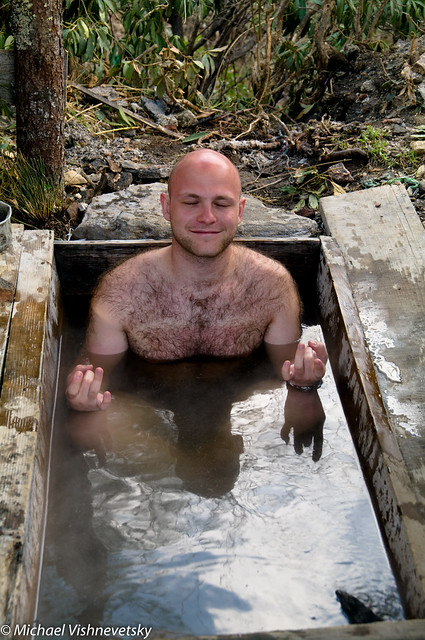
Later back to my meditative bath, I was reminded of the Beatles song, Within You Without You, written by George Harrison. I miss you, George.
Saturday, April 23, 2011
Little Miss Bhutan
Chencho's little niece, Tandril, whom I photographed at the playground on my last day (March 14) in Thimphu, as per her mother's request. Tandril is inexplicably cute, and, though doesn't quite speak English, knew to point at the monkey image on my shirt and say "what is dis monkey?"
Though Tandril didn't feel in the mood for photos, I got her in a beautiful candid pose, and then applied some Lightroom magic to bring out the designs on her costume, to really draw the viewer's attention to her adorable face.
Though Tandril didn't feel in the mood for photos, I got her in a beautiful candid pose, and then applied some Lightroom magic to bring out the designs on her costume, to really draw the viewer's attention to her adorable face.
Thursday, April 21, 2011
Recess in Bhutan
So at the end of Day 2 in Bhutan, Chencho drove me up to this monastery, like most monasteries here, hidden away up high, and only accessible via windy road hugging a mountain. Right around sunset, the monk students were let out from their late afternoon courses. This young boy spent his break pensively staring out at the world, basking in all its natural beauty in front of him. He looked so peaceful staring at the mountain range ahead, and made me wonder about how this recess was unlike what we were all used to as schoolchildren. And that thought just blew me away, really helping me to better understand what this special society is about. Imagine growing up with hours of quality time with yourself and the natural world. Not only would this explain the profound appreciation for the beautiful offerings of Mother Earth, but also would shed some light on the Drukpa's excellent understanding of themselves. They are immensely comfortable with themselves, their way of life, and their fellow people. Theirs is a culture of very self aware people, and I'll give more concrete examples in some other post(s).
Wednesday, April 20, 2011
Encounters with Project DANTAK
It's Day 2 of my trip, and today we went on a little hike. Paro is a valley, meaning that it's surrounded by mountain ranges, some accessible, and many insurmountable. Chencho drove up this windy, scenic, path, from Paro (altitude ~2250m) to Chele la pass (altitude ~4000m), separating Paro Valley and Haa valley. Once we had reached the higher altitudes, we noticed a lot of snow left on the ground from a recent snowfall. So we devoted a good 30 minutes to some old fashioned snow play.
Also, we began to encounter Yaks on the side of the road, something that would become an all-too-common sight in Bhutan. Yaks are very interesting creatures with tremendous importance to the Bhutanese, as many take up Yak herding in order to retrieve milk products and make smoked meats for sale at local markets. Yaks prefer cold climates, and therefore seldom venture down to the valleys. The range of Yak personalities is huge, in that you never know whether a Yak is a peaceful, unfazed, creature, or a belligerent, easily annoyed brute.
As we (the car) climbed, there was a very noticeable change in forest type, as blue pine trees gave way to aromatic juniper, hemlock, spruce, and silver fir, which finally gave way to fragrant shrubs, open meadows, and moss. With their sacred importance, these forests are strictly protected, meaning that no one is allowed to cut the trees here. Juniper might be the most sacred tree for the Bhutanese, as it's twigs represent life, it's potent incense considered to be the perfume of the Gods, and the tree itself the home and representation of the fertility goddess. It is burned in most homes (usually in the altar room, which most if not all homes here have) and in monasteries.
Up at Chele La, we were blessed with our fair share of stunning views, all around. Prayer flags beating to the force of high winds, I began to realize that these simple experiences are the stuff of the Good Life.

Up at Chele la pass, there was this cool view boasting some of the Himalayas' highest mountains. Jomolhari, with its peak at around 20,000 Ft., is the white capped one on the left. I noticed this fantastic opportunity created by the prayer flags, since I've been exploring the use of objects in a scene as frames to point the viewer's attention to a central subject.
As we drove down the road on our descent back to Paro, we noticed these Indians heating and pushing around tar. Chencho told me that they are migrant workers under hire by Project DANTAK, which has been building Bhutan's motorable roads for 50 years now (with Bhutan's first road built in 1960). They usually stay in tents and move around as their project location changes. I got out of the car, and started to investigate their work and living spaces; no one seemed to mind that I was snooping around. Their tents are very minimalist, probably not very pleasant to stay in. Luckily water in the this region is clean, due to the altitude, and it's dry enough this time of the year to make a fire relatively easy.
It was really striking and unnerving to learn about the poor health standards these workers are dealing with, especially when you consider the proximity of these working areas to the tents. In order to pave these road, tar is freely burned, releasing all sorts of toxic fumes into the air. The people are not given any type of protective masks to protect them from the gases and soot released from this burning. Probably a cost-cutting measure by their bosses, but I don't know the whole story of this so can't say for sure. These workers bring their kids with them (since their time in Bhutan usually extends to years), and the kids are often nearby the sites of tar heating, inhaling all of this crap in the air. Clearly some serious health standards being ignored, putting these kids in serious danger. There are schools that have been established for the children of the Project DANTAK workers. I do wish I could have investigated the state of those schools, since I really do not know anything about their quality, or what percent of the children who should be going to school actually end up going (whether because of limited space or some other reason).
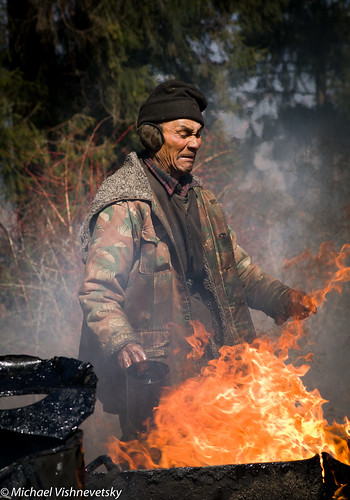
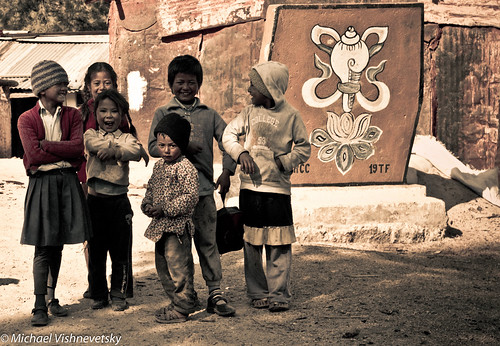
Some Nepali kids I saw at the roadside. I think their parents work for the Dentak road building project, and so they probably migrate quite often, living in tents or pretty rundown shacks like the one behind them. Like many kids, these were just pure naturals with a lot of character.
Also, we began to encounter Yaks on the side of the road, something that would become an all-too-common sight in Bhutan. Yaks are very interesting creatures with tremendous importance to the Bhutanese, as many take up Yak herding in order to retrieve milk products and make smoked meats for sale at local markets. Yaks prefer cold climates, and therefore seldom venture down to the valleys. The range of Yak personalities is huge, in that you never know whether a Yak is a peaceful, unfazed, creature, or a belligerent, easily annoyed brute.
As we (the car) climbed, there was a very noticeable change in forest type, as blue pine trees gave way to aromatic juniper, hemlock, spruce, and silver fir, which finally gave way to fragrant shrubs, open meadows, and moss. With their sacred importance, these forests are strictly protected, meaning that no one is allowed to cut the trees here. Juniper might be the most sacred tree for the Bhutanese, as it's twigs represent life, it's potent incense considered to be the perfume of the Gods, and the tree itself the home and representation of the fertility goddess. It is burned in most homes (usually in the altar room, which most if not all homes here have) and in monasteries.
Up at Chele La, we were blessed with our fair share of stunning views, all around. Prayer flags beating to the force of high winds, I began to realize that these simple experiences are the stuff of the Good Life.

Up at Chele la pass, there was this cool view boasting some of the Himalayas' highest mountains. Jomolhari, with its peak at around 20,000 Ft., is the white capped one on the left. I noticed this fantastic opportunity created by the prayer flags, since I've been exploring the use of objects in a scene as frames to point the viewer's attention to a central subject.
As we drove down the road on our descent back to Paro, we noticed these Indians heating and pushing around tar. Chencho told me that they are migrant workers under hire by Project DANTAK, which has been building Bhutan's motorable roads for 50 years now (with Bhutan's first road built in 1960). They usually stay in tents and move around as their project location changes. I got out of the car, and started to investigate their work and living spaces; no one seemed to mind that I was snooping around. Their tents are very minimalist, probably not very pleasant to stay in. Luckily water in the this region is clean, due to the altitude, and it's dry enough this time of the year to make a fire relatively easy.
It was really striking and unnerving to learn about the poor health standards these workers are dealing with, especially when you consider the proximity of these working areas to the tents. In order to pave these road, tar is freely burned, releasing all sorts of toxic fumes into the air. The people are not given any type of protective masks to protect them from the gases and soot released from this burning. Probably a cost-cutting measure by their bosses, but I don't know the whole story of this so can't say for sure. These workers bring their kids with them (since their time in Bhutan usually extends to years), and the kids are often nearby the sites of tar heating, inhaling all of this crap in the air. Clearly some serious health standards being ignored, putting these kids in serious danger. There are schools that have been established for the children of the Project DANTAK workers. I do wish I could have investigated the state of those schools, since I really do not know anything about their quality, or what percent of the children who should be going to school actually end up going (whether because of limited space or some other reason).

This guy is working with Project Dentak, an initiative which brings Indian migrant workers to Bhutan to pave Bhutan's roads. I think he poured some oil or maybe tar into the flame and it just burst unexpectedly. To me this image adequately represents the dangers of this type of work, along with the poor health standards under which the people are working.
A little down the road, we met some of the cutest, most photogenic, children I've ever encountered. They made love to the camera, so to speak.

Some Nepali kids I saw at the roadside. I think their parents work for the Dentak road building project, and so they probably migrate quite often, living in tents or pretty rundown shacks like the one behind them. Like many kids, these were just pure naturals with a lot of character.
Wednesday, April 13, 2011
Kuzu Zampola, Druk-Yul! / What's up, Land of the Thunder Dragon!
I'm back from my very much unplanned blogging hiatus. I guess I've been focusing much more on my photography and lab work, but of course I've been taking notes on my experiences over the past months. Somehow that never carried over into cyberspace. I'm planning to backtrack my steps and fill you all in on some amazing experiences I've had the privilege to enjoy in the past months.
Most significant I would say has been my recent (March 1-15) trip to Bhutan, a tiny little Buddhist kingdom in the Eastern Himalayas, surrounded by countries like Nepal and India, with Tibet just over some really tall and insurmountable rock. In an earlier post, I expressed my interest in traveling to this last Shangri-la, though originally I had thought about joining National Geographic's expedition to Bhutan. Of course then I found out that I'm pretty darn lucky, as Chencho Dorji, research officer from the National Biodiversity Centre in Bhutan, had visited SBC a month before I first arrived, and left an open invitation to all the staff. I was encouraged to pursue his council on planning my trip, and over facebook, we became friends and he expressed his commitment to giving me the "total experience" [of Bhutan]. He was able to get me a visa (natives are allowed 2 visas that they may extend to outsiders), saving me around $200/day over a 15 day trip. Of course I didn't know this at the time, but this amicable fellow also has a tour guide license and knows a great deal about his country, especially botany/ethnobotanical traditions. An added twist of fate/fortune made it so the Enrichment conference (Present your work for 20 minutes, shmooze and booze in Bangkok for 4 days) for Fulbrighters in S.E. Asia was planned to start the day after I finished my Bhutan trip, and that the event would be in one of only three cities providing flights to Bhutan's single airport in Paro. Fulbright would cover my trips between Kuching and Bangkok. Win.
So thinking about how to organize this post has been stressing me out a bit, since there is just so much I would like to cover, and I want to put it together in a digestible fashion. I figure I might divide up my spiel into a few separate posts.
Getting to Bhutan
First off, the way my flights were arranged, I had to spend a day at Bangkok's Suvarnabhumi airport- not a bad one to spend a day at, since I was able to enjoy a massage and multiple different curries (not to be combined though). Also had I needed urgent medical attention, there is an excellent medical clinic in the airport as well. I also had some time to observe and appreciate the many different strategies people employ in trying to get some shuteye at an airport- you've got people with comforters, pillows, and even eye masks who lay out on the floor in luxury; then there are those who nod off while in a chair, with their heads slowly drifting down before they sense themselves falling and wake up (only to nod off again in a matter of seconds); there are some unique cases of people sitting on one piece of luggage and resting their heads on another set of luggage. Anyway, onto more interesting topics.
My flight to Paro, Bhutan, was being serviced by Druk Air, the only airline that flies to and from Bhutan. The flight lasted about 4 hrs, ending in a beautiful sunrise and descent that included our plane wrapping around snow-capped mountain ranges and finally landing in the valley. Not even exiting the plane, I was already entranced by the majestic landscape all around me.
I was greeted by my new friend Chencho, and we drove a short bit to his granny's house, where his cousin already prepared some breakfast, including some red rice, toast with homemade jam, and butter tea, a Bhutanese specialty. This butter tea is made with salt, freshly churned butter, and local tea leaves. It was unbeatable in its ability to warm and relieve my cold-shocked body. It was probably not even that cold, like between 10 and 15 degrees centigrade; but a crazy jump to make from the tropical paradises I just flew in from. After this simple comfort and some quality time near their kitchen's wood heater (kind of a furnace for wood burning connected to a chimney) we went off to his aunt's home, where I took a much needed nap.
For lunch we enjoyed some Traditional Bhutanese food. Some of it was adapted from Indian cuisine. I totally did not mind the daal and paneer we were served. But I immediately fell in love with Bhutanese food (big surprise there). It was the succulent and mouth/nose watering chili chicken, the savory dumplings, super spicy long beans, a soul-warming hot and sour chicken soup, and a hefty serving of Bhutanese beer I was poured. Of course all of these dishes were just the supporting cast to these people's real mainstay, RICE. Red rice is a specialty of this region and I had heapfuls of it. Yep, I can live well here.
Since I did not want to lounge around on my first of few days in this amazing country, we visited Ta-Dzong, which used to be a fortress overlooking the all important Dzong of Paro.
Dzongs function as administrative buildings for each District, but also are often monasteries/temples, and therefore sites of incredible buddhist spiritual clout. Ta-Dzong has now become a museum of all things Bhutanese- weapons used in battle, utensils and cooking ware, stamps, art, etc. Unlike any other museum I've been to, many of these items, though seemingly antique, are actually used in regular rural life throughout Bhutan. This understanding was the first of several realizations that have utterly blown my mind with regard to how unique these people and their land are.
Next we stopped by the famous Paro Dzong, and stumbled upon some monks/mini-monks (my word for youngsters in their first years on the path to becoming a monk) practicing special dances they would later perform at the famous Buddhist festival called "Tsechu," known to be especially glamourous in Paro (it becomes like a runway for the most extravagant displays of Kira modeling (Kira is the traditional dress of women in Bhutan, worn at official functions (often to work), and special cultural/social/religious occasions).
These Tsechus are major scenes of flirtation and courtship (a word pretty much out of use except for in the field of entomology, and yet appropriate in the very traditional Bhutanese society). While at the tsechus monks would be clad in costume and their faces masked, here they were out in the open, dancing near a monastery. The teacher was demonstrating his moves and the students were to follow. I was fortunate enough to get some shots of these exercises in mentorship, and also was able to convey an important point: that even monks have their moments of 'weakness', of 'imperfection', and of obliviousness, while at the same time providing tremendous inspiration and spiritual consolation to many people out there.
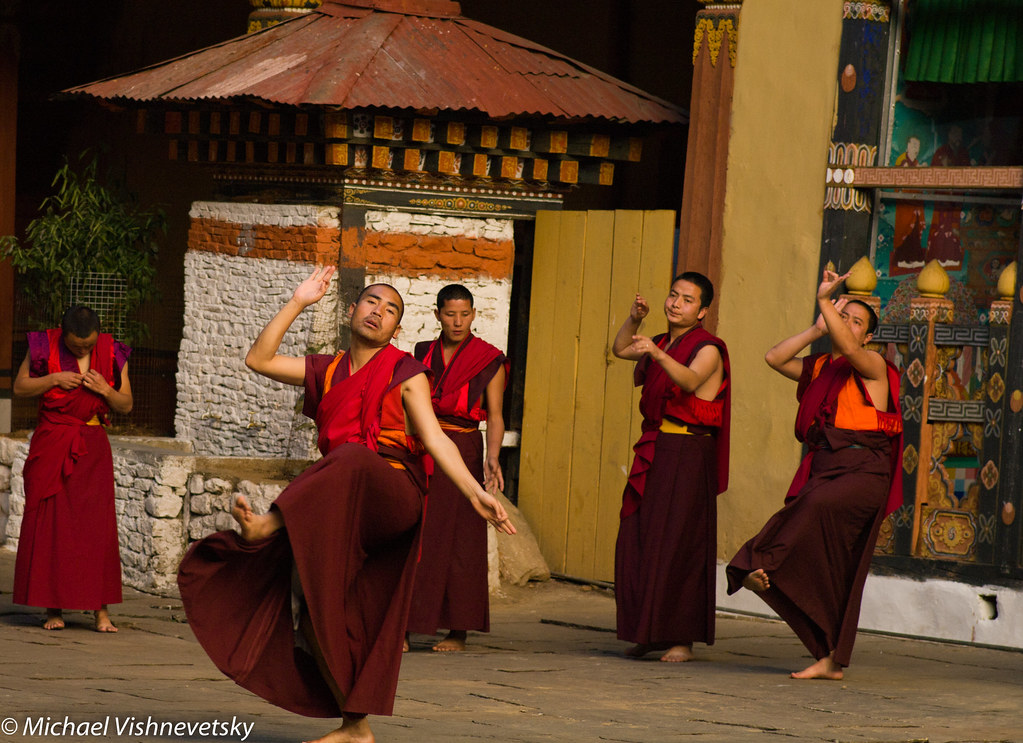
Day one and already my impression of Bhutan is intensely rich and multi-layered. From this day forth, I have continued to remain enraptured by the magic of this place. Every single day in Bhutan, i would continue to feel moved by the people, culture, environment, and inexplicably beautiful spirituality pervading every space in the land of the thunder dragon.
Most significant I would say has been my recent (March 1-15) trip to Bhutan, a tiny little Buddhist kingdom in the Eastern Himalayas, surrounded by countries like Nepal and India, with Tibet just over some really tall and insurmountable rock. In an earlier post, I expressed my interest in traveling to this last Shangri-la, though originally I had thought about joining National Geographic's expedition to Bhutan. Of course then I found out that I'm pretty darn lucky, as Chencho Dorji, research officer from the National Biodiversity Centre in Bhutan, had visited SBC a month before I first arrived, and left an open invitation to all the staff. I was encouraged to pursue his council on planning my trip, and over facebook, we became friends and he expressed his commitment to giving me the "total experience" [of Bhutan]. He was able to get me a visa (natives are allowed 2 visas that they may extend to outsiders), saving me around $200/day over a 15 day trip. Of course I didn't know this at the time, but this amicable fellow also has a tour guide license and knows a great deal about his country, especially botany/ethnobotanical traditions. An added twist of fate/fortune made it so the Enrichment conference (Present your work for 20 minutes, shmooze and booze in Bangkok for 4 days) for Fulbrighters in S.E. Asia was planned to start the day after I finished my Bhutan trip, and that the event would be in one of only three cities providing flights to Bhutan's single airport in Paro. Fulbright would cover my trips between Kuching and Bangkok. Win.
So thinking about how to organize this post has been stressing me out a bit, since there is just so much I would like to cover, and I want to put it together in a digestible fashion. I figure I might divide up my spiel into a few separate posts.
Getting to Bhutan
First off, the way my flights were arranged, I had to spend a day at Bangkok's Suvarnabhumi airport- not a bad one to spend a day at, since I was able to enjoy a massage and multiple different curries (not to be combined though). Also had I needed urgent medical attention, there is an excellent medical clinic in the airport as well. I also had some time to observe and appreciate the many different strategies people employ in trying to get some shuteye at an airport- you've got people with comforters, pillows, and even eye masks who lay out on the floor in luxury; then there are those who nod off while in a chair, with their heads slowly drifting down before they sense themselves falling and wake up (only to nod off again in a matter of seconds); there are some unique cases of people sitting on one piece of luggage and resting their heads on another set of luggage. Anyway, onto more interesting topics.
My flight to Paro, Bhutan, was being serviced by Druk Air, the only airline that flies to and from Bhutan. The flight lasted about 4 hrs, ending in a beautiful sunrise and descent that included our plane wrapping around snow-capped mountain ranges and finally landing in the valley. Not even exiting the plane, I was already entranced by the majestic landscape all around me.
I was greeted by my new friend Chencho, and we drove a short bit to his granny's house, where his cousin already prepared some breakfast, including some red rice, toast with homemade jam, and butter tea, a Bhutanese specialty. This butter tea is made with salt, freshly churned butter, and local tea leaves. It was unbeatable in its ability to warm and relieve my cold-shocked body. It was probably not even that cold, like between 10 and 15 degrees centigrade; but a crazy jump to make from the tropical paradises I just flew in from. After this simple comfort and some quality time near their kitchen's wood heater (kind of a furnace for wood burning connected to a chimney) we went off to his aunt's home, where I took a much needed nap.
For lunch we enjoyed some Traditional Bhutanese food. Some of it was adapted from Indian cuisine. I totally did not mind the daal and paneer we were served. But I immediately fell in love with Bhutanese food (big surprise there). It was the succulent and mouth/nose watering chili chicken, the savory dumplings, super spicy long beans, a soul-warming hot and sour chicken soup, and a hefty serving of Bhutanese beer I was poured. Of course all of these dishes were just the supporting cast to these people's real mainstay, RICE. Red rice is a specialty of this region and I had heapfuls of it. Yep, I can live well here.
Since I did not want to lounge around on my first of few days in this amazing country, we visited Ta-Dzong, which used to be a fortress overlooking the all important Dzong of Paro.
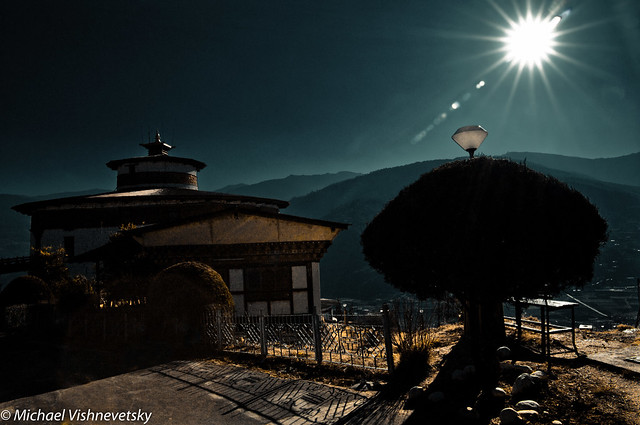 |
| Ta-Dzong. Experimenting with some cool presets in the photoediting software, in order to convey the mysterious, serene, and mystical aura I am sensing in Bhutan. |
Dzongs function as administrative buildings for each District, but also are often monasteries/temples, and therefore sites of incredible buddhist spiritual clout. Ta-Dzong has now become a museum of all things Bhutanese- weapons used in battle, utensils and cooking ware, stamps, art, etc. Unlike any other museum I've been to, many of these items, though seemingly antique, are actually used in regular rural life throughout Bhutan. This understanding was the first of several realizations that have utterly blown my mind with regard to how unique these people and their land are.
Next we stopped by the famous Paro Dzong, and stumbled upon some monks/mini-monks (my word for youngsters in their first years on the path to becoming a monk) practicing special dances they would later perform at the famous Buddhist festival called "Tsechu," known to be especially glamourous in Paro (it becomes like a runway for the most extravagant displays of Kira modeling (Kira is the traditional dress of women in Bhutan, worn at official functions (often to work), and special cultural/social/religious occasions).
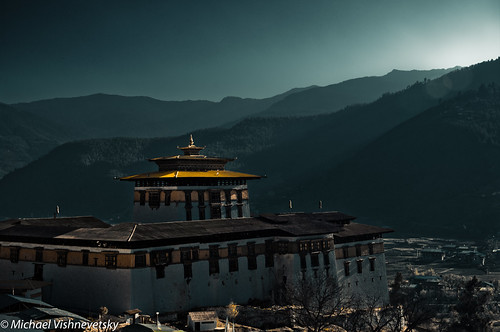 |
| Paro Dzong. Same edit as for the Ta-Dzong. |

Day one and already my impression of Bhutan is intensely rich and multi-layered. From this day forth, I have continued to remain enraptured by the magic of this place. Every single day in Bhutan, i would continue to feel moved by the people, culture, environment, and inexplicably beautiful spirituality pervading every space in the land of the thunder dragon.
Sunday, April 10, 2011
Bako: Cinnamon trees, Deserted Beaches, and Naughty Macaques with Cataracts
Somehow I've been in Kuching for around 7 months, without venturing to Bako National park, only a 30 minute boat ride from Kuching. This is a very famous and popular national park in Sarawak, playing host to a number of Borneo's most treasured, unique, and baffling organisms. Well this weekend, it was a nice group of us, including Gilbert, Holed, Harny, Michelle, and her fiance, Andrew. We rented a chalet and planned for a 3 day, 2 night stay.
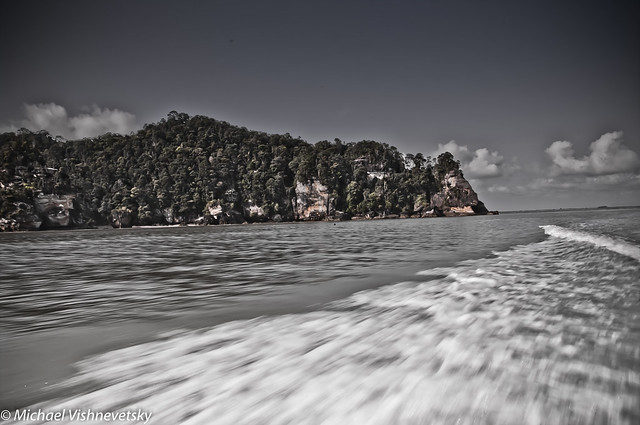
On our way to the park.
The trip was part work, part play, as I also did a small collection of plants at the park. Gilbert, Holed, and Harny helped me track down some of the Cinnamomum (various species of Cinnamon) in the area, so that I could collect small samples of those and neighboring plants for my microbial isolation. Why those plants in particular? Let's leaf that for a soon-to-come post. Just take it on faith for now, that these plants might have special qualities, potentially influencing microbial life dwelling within their cellulose-fortified, photosynthetic, bastions.
I'm not going to detail every aspect of our trip but will note important highlights in nonsentence form.
-excellent trails here, not too huge so as to destroy much flora, but clear and exciting in the range of terrain traversed.
-pitcher plants (Nepenthes ampularia among others) galore in some of the peat swamp and kerangas forests
-I never knew before this trip that pitcher plants are hang-out spots for hermit crabs
-First time swimming in a sea (South China) whose water felt hotter than the air outside.
-Fun night hike with all sorts of odd critters. Frogs (see photo below), some poisonous; poisonous spider; civet cat, skipping around up in the canopy; grasshoppers; stick insects; etc. There was plenty that we did not get to see, but that's part of the excitement of being here: it's all wild, unfettered, beauty; nothing fabricated, no circus acts, nor scheduled sightings. Just life, in all of its glorious [and sometimes not-so-glorious) serendipity.
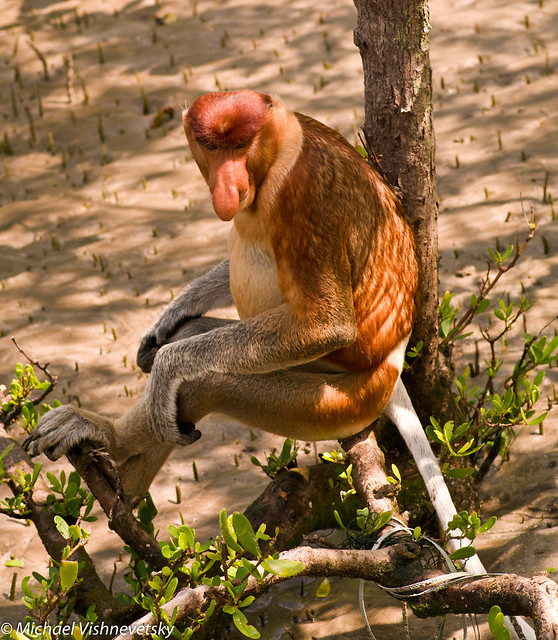
At 7am on our second day at Bako, we woke up and started to prepare our simple instant mee noodle breakfasts. Right around the time we were sitting down to get sustenance for the day-long hike, we heard loud thumps on the roof. All of a sudden, a macaque peeks over the edge of the roof to check out the scene on the ground floor. We've got these suckers in the bag, he's probably thinking, as he then likely reported his observations to rest of the crew. And so, less than a minute later, the brigade drops down for operation Chili Tuna. They surrounded our chalet and some tried to distract us with their cute appeals, while others began making attempts at our table of food. We quickly moved the food to the kitchen and closed the door, but alas. A single can of chili tuna was taken captive and devoured before our eyes. Oh those sly devils are good. We just knew in advance they'd try underhanded tricks like these, so we had sticks to scare them off. For the common, unknowing tourist, however, things go far worse in many cases. Usually these monkeys can conduct whole raids on a kitchen, as we even witnessed several opening a refrigerator door and grabbing goodies out. These monkeys are far too comfortable with humans.
How'd they get so fearless I wonder?
My guess is that for year, humans were around, not causing harm, even offering food to these monkeys, as we all have a sore spot for cute, fuzzy, mammals, especially primates. So these guys got super accustomed to our offerings and probably figured we wouldn't hurt them, even if they pulled antics like the ones I described above.
Oh yeah, I guess I'm using full sentences now, oops.
-second day, we ventured on a 7 hour trip(3.5 hour there, about 2.5 hour back, about one hour for lunch and hanging out) to another beach, called Telok Sibur. This walk was more difficult than the last one, especially the last 45 minutes of steep descent. Originally we were thinking of getting on a boat from this beach to return back, but there was no phone signal and so none of us could contact the park office to request a boat. I was happy to walk back, but it meant we didn't have much time at the beach. The beach was totally deserted, not a soul in sight. I felt like LOST could have been filmed on this beach, except that the high tide midday floods all the terrain up to the slope For a while I thought I was seeing monkeys on the far end, but I was just being delusional and hopeful. Probably dehydration, or just being myself.
Holed and I decided to take a dip in the water, but it was just plain unpleasant because it was so hot I could have poached an egg in it.
-And then we walked back, by the end I was very much in need of 100 plus, the ultimate hydrating force here (sprite meets gatorade). I inhaled three cans and a liter of water within a minute.
-old macaque with cataract in one eye seems more polite than others. He'll take the food you offer him and eat it gently in front of you, unlike the younger ones, who will slyly approach, snatch it and speed to safety, fighting over it with others and devouring the snack.
-we had fun making some lewd light graffiti.
-I photographed a beatle imprisoned by a fan.
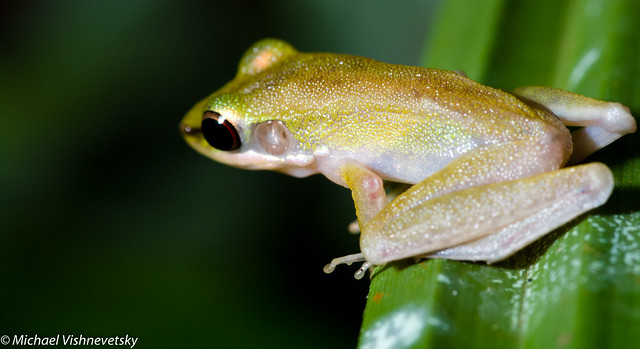
More photos here.

On our way to the park.
The trip was part work, part play, as I also did a small collection of plants at the park. Gilbert, Holed, and Harny helped me track down some of the Cinnamomum (various species of Cinnamon) in the area, so that I could collect small samples of those and neighboring plants for my microbial isolation. Why those plants in particular? Let's leaf that for a soon-to-come post. Just take it on faith for now, that these plants might have special qualities, potentially influencing microbial life dwelling within their cellulose-fortified, photosynthetic, bastions.
I'm not going to detail every aspect of our trip but will note important highlights in nonsentence form.
-excellent trails here, not too huge so as to destroy much flora, but clear and exciting in the range of terrain traversed.
-pitcher plants (Nepenthes ampularia among others) galore in some of the peat swamp and kerangas forests
-I never knew before this trip that pitcher plants are hang-out spots for hermit crabs
-First time swimming in a sea (South China) whose water felt hotter than the air outside.
-Fun night hike with all sorts of odd critters. Frogs (see photo below), some poisonous; poisonous spider; civet cat, skipping around up in the canopy; grasshoppers; stick insects; etc. There was plenty that we did not get to see, but that's part of the excitement of being here: it's all wild, unfettered, beauty; nothing fabricated, no circus acts, nor scheduled sightings. Just life, in all of its glorious [and sometimes not-so-glorious) serendipity.

At 7am on our second day at Bako, we woke up and started to prepare our simple instant mee noodle breakfasts. Right around the time we were sitting down to get sustenance for the day-long hike, we heard loud thumps on the roof. All of a sudden, a macaque peeks over the edge of the roof to check out the scene on the ground floor. We've got these suckers in the bag, he's probably thinking, as he then likely reported his observations to rest of the crew. And so, less than a minute later, the brigade drops down for operation Chili Tuna. They surrounded our chalet and some tried to distract us with their cute appeals, while others began making attempts at our table of food. We quickly moved the food to the kitchen and closed the door, but alas. A single can of chili tuna was taken captive and devoured before our eyes. Oh those sly devils are good. We just knew in advance they'd try underhanded tricks like these, so we had sticks to scare them off. For the common, unknowing tourist, however, things go far worse in many cases. Usually these monkeys can conduct whole raids on a kitchen, as we even witnessed several opening a refrigerator door and grabbing goodies out. These monkeys are far too comfortable with humans.
How'd they get so fearless I wonder?
My guess is that for year, humans were around, not causing harm, even offering food to these monkeys, as we all have a sore spot for cute, fuzzy, mammals, especially primates. So these guys got super accustomed to our offerings and probably figured we wouldn't hurt them, even if they pulled antics like the ones I described above.
Oh yeah, I guess I'm using full sentences now, oops.
-second day, we ventured on a 7 hour trip(3.5 hour there, about 2.5 hour back, about one hour for lunch and hanging out) to another beach, called Telok Sibur. This walk was more difficult than the last one, especially the last 45 minutes of steep descent. Originally we were thinking of getting on a boat from this beach to return back, but there was no phone signal and so none of us could contact the park office to request a boat. I was happy to walk back, but it meant we didn't have much time at the beach. The beach was totally deserted, not a soul in sight. I felt like LOST could have been filmed on this beach, except that the high tide midday floods all the terrain up to the slope For a while I thought I was seeing monkeys on the far end, but I was just being delusional and hopeful. Probably dehydration, or just being myself.
Holed and I decided to take a dip in the water, but it was just plain unpleasant because it was so hot I could have poached an egg in it.
-And then we walked back, by the end I was very much in need of 100 plus, the ultimate hydrating force here (sprite meets gatorade). I inhaled three cans and a liter of water within a minute.
-old macaque with cataract in one eye seems more polite than others. He'll take the food you offer him and eat it gently in front of you, unlike the younger ones, who will slyly approach, snatch it and speed to safety, fighting over it with others and devouring the snack.
-we had fun making some lewd light graffiti.
-I photographed a beatle imprisoned by a fan.

More photos here.
Subscribe to:
Posts (Atom)
